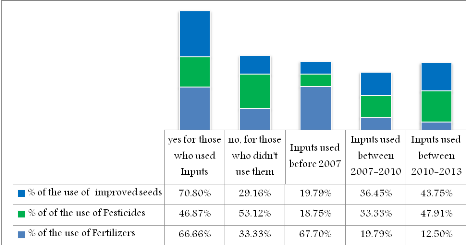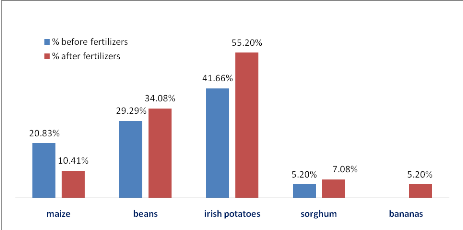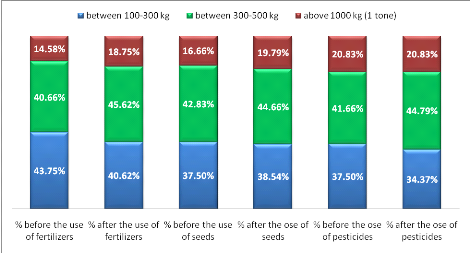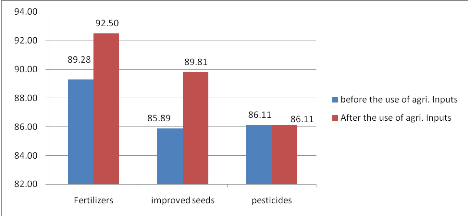4.4. Respondents view on
the use of improved seeds, pesticides and fertilizers
The information about the use of agricultural inputs was very
important in this study because it helps us to figure out how the use of
fertilizers has helped farmers to improve food production, improved seeds in
this study was to help us find out their contribution in promoting food
security and it was also very important in this study to examine the role of
the use of pesticides to increase production in rural area of CYANI sector
Figure 2: Snapshot of the
use of improved seeds, pesticides and fertilizers
Source: Results of field study,
2014

This study shows that around 71% of the household surveyed had
used improved seeds in last two years while 29% they didn't. From those who
reported to use improved seeds, 19.7% start to use them before 2007, 36.4% and
43.7% started to use them between 2007- 2010 and between 2010 -2013
respectively
Again referring to the above figure, it is clear that 46.8% of
the sample surveyed have used pesticides in last two years while 53.1% they
didn't. From those who reported to use pesticides, almost 19% start to use them
before 2007 where 33% started to use the between 2007 and 2010 while about 48%
started between 2010 to 2013
Finally, approximately 67% of the household surveyed use
fertilizers while 33% they didn't. from those who reported to use fertilizers,
68% start to use them before 2007 (the year by which MINAGRI developed the Crop
Intensification Program (CIP) with the aim of increasing agricultural
productivity and food security in Rwanda), 20% started to use the between 2007
and 2010 while 12% started between 2010 to 2013 This shows that there is an
increasing trend in the use of agricultural inputs well done to the Ministry of
Agriculture and Animal Resources through the Crop Intensification Program (CIP)
established in 2007
4.5. Respondent's view on
the crops grown before and after the use of fertilizers
In this aspect we would like to analyze role of the use of
fertilizers based on the crop grown before and after they start to use this
agricultural input. The table below examines the respondent's views about this
information
Figure 3: The proportions of
crops grow before and after the use of fertilizers
Source: Results of field study,
2014

The results of the current study highlighted the perceptions
of the use of fertilizers. It revealed that 41.6%%, 29.2% reported that Irish
potatoes and beans respectively were their favorite crops before the use of
fertilizers and after, Irish potatoes and beans continue to be the major crops
and the rates has increased whether for Irish potatoes, beans and sorghum but
also an introduction of a new crop namely banana that was at the rate of 5.2%
of cultivation
4.6. Observations on the
crop production before and after the use of Improved agricultural practices
The observation on these variables (inputs) will help us to
examine the impact of agricultural inputs on the availability of food
production based on the perception of the respondent on each of the three
inputs namely Fertilizers, improved seeds and insecticides around CYANIKA
Sector
Figure 4: The percentages of
production before and after the use of agricultural inputs
Source: Results of field study,
2014

Looking at the graph above, we note the following:
§ There was no significant improvement observed on the HH
that were producing between 100-300kg before and after the use of fertilizers
(40.76% to 40.62% respectively)
§ Due to the use of fertilizers, HH that their harvest
was in the range of 300-500kg, were raised from 40.66% to 45.62% before and
after the use of fertilizers
§ It is also shown by looking at the above graph, HH that
were producing above 1000Kh (Tone) before and after the use of fertilizers, was
significantly increased from 14.5% to 18.7% respectively
§ On the use of improved seeds, the above table shows
that HH that were producing between 100-300kg before and after the use of
improved seeds shifted from 37.5% to 38.5% respectively which indicate an
tremendous increment in the production because more HH shifted from this group
to the next (100-300kg to 300-500kg respectively)
§ Due to the use of improved seeds, HH that harvested
between 300-500g and above tones of production, the proportions indicate that
there is a considerable increase in the farmer's production (seen the above
graph)
§ By comparing before and after the use of pesticides,
there is an increase in production among HH that were producing between
100-300kg and 300-500kg but on the third group (above 100kg/1 tone) was not
improved
Figure 5: The proportion of
the overall production before and after each agricultural input
Source: Results of field study,
2014

Looking at the graph above, it shows a remarkable improvement
on the food production based on use of fertilizers and improved seeds where the
rates was shifted from 89.28% to 92.50% for fertilizers and
from 85.89% to 89.81% for improved seeds respectively in the
year 2002-2013 while looking at the pesticides, there was no improvement
Once we were interest to find out the role of the use
fertilizers and improved seeds and pesticides in increasing food production, it
is clear that they have helped much the farmers to raise their agricultural
production
| 


